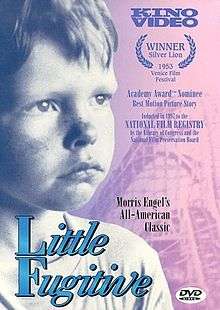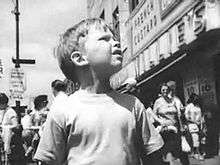Little Fugitive
| Little Fugitive | |
|---|---|
 Cover of Kino Video DVD release | |
| Directed by |
Ray Ashley Morris Engel Ruth Orkin |
| Produced by |
Ray Ashley Morris Engel |
| Screenplay by |
Ray Ashley Morris Engel Ruth Orkin |
| Starring |
Richie Andrusco Richard Brewster |
| Music by | Eddie Manson |
| Cinematography | Morris Engel |
| Edited by |
Ruth Orkin Lester Troob |
| Distributed by | Joseph Burstyn Inc. |
Release dates |
|
Running time | 80 minutes |
| Country | United States |
| Language | English |
Little Fugitive (1953) is an American film written and directed by Raymond Abrashkin (as "Ray Ashley"), Morris Engel and Ruth Orkin, that tells the story of a child alone in Coney Island.
The film stars Richie Andrusco in the title role, and Richard Brewster as his brother Lennie.[1]
Little Fugitive influenced the French New Wave and is considered by modern-day critics to be a landmark film because of its naturalistic style and groundbreaking use of nonprofessional actors in lead roles. It was nominated for an Academy Award for Best Writing, Motion Picture Story and screened at Venice film festival where it was awarded the silver lion.
In 1997, the film was selected for preservation in the United States National Film Registry by the Library of Congress as being "culturally, historically, or aesthetically significant".
It was the first and best known of Engel's three feature films. It was followed by Lovers and Lollipops in 1956 and Weddings and Babies, which was filmed in 1957 and released in 1960. All three films were similar stylistically, and were filmed with hand-held 35 mm. cameras. The cameras used in the first two movies did not record sound, and dialogue was dubbed subsequent to filming. Weddings and Babies was the first fiction feature filmed with a portable camera that allowed synchronized sound.
Plot

Joey Norton, seven years old, lives with his older brother Lennie in a lower-middle-class neighborhood of Brooklyn. Joey is too small to be taken seriously by Lennie and Lennie's friends.
One day, while their mother is away visiting her sick mother, Lennie and his friends play a joke on Joey. They stage an incident using catsup and a toy gun, so that Joey thinks he has shot and killed his brother.
Joey, who is told the police will catch and imprison him, runs to the nearest elevated train station and flees to Coney Island. He seems to forget his predicament and spends the day wandering around the arcades, pony rides, beach—a little boy's paradise. He gets money for snacks by cashing in deposit bottles, and spends the night sleeping under the boardwalk. Meanwhile, Lennie is frantically trying to find him, as their mother is due home soon.
Joey loves horses, and he begins hanging around a pony ride. The proprietor of the ride becomes suspicious that Joey is a runaway. He tricks Joey into giving him his address. He calls home and alerts Lennie. Lennie comes to Coney Island and, after a frantic search, finds little Joey.
Their mother returns just after the two brothers arrive home. She is unaware of what happened, and, pleased that her two sons behaved so well during her absence, says they will have a treat that weekend: a trip to Coney Island!
Cast
- Richie Andrusco as Joey Norton
- Richard Brewster as Lennie Norton
- Winifred Cushing as Mother
- Jay Williams as Jay the Pony Ride Man
- Will Lee as Photographer
- Charlie Moss as Harry
- Tommy DeCanio as Charley
Cast notes
The lead character of Joey was played by Richie Andrusco, a nonprofessional actor who never appeared in any other film. The other actors in the film were also largely nonprofessionals. Actor Will Lee (who later played Mr. Hooper on Sesame Street) made a cameo appearance as a Coney Island photographer. Writer/director Raymond Abrashkin and actor Jay Williams would later co-author the "Danny Dunn" series of juvenile science fiction novels.
Production notes
The movie was filmed on location at Coney Island and Brooklyn, United States; using a unique, concealed strap-on camera, which made it possible for Engel to work without a tripod and large crew. It allowed him to have thousands of beach-going New Yorkers as extras without their knowing it.[2] The device could be seen as a prototype for the Steadicam and was designed by him and the inventor Charlie Woodruff, a friend and fellow combat photographer he met during World War II, whom Engel called a "“mechanical and engineering genius." This innovation proved to be "the heart and soul of why Little Fugitive was possible." Over the years, filmmakers such as Stanley Kubrick and Jean-Luc Godard were eager to borrow this unique camera.
Reception
Critical response
The film was greeted by critical acclaim at the time, and was a major influence on the French New Wave.
François Truffaut was inspired by Little Fugitive's spontaneous production style when he created The 400 Blows (1959), saying long afterwards: "Our New Wave would never have come into being if it hadn't been for the young American Morris Engel, who showed us the way to independent production with [this] fine movie."[3]
Modern critics have also praised the film. Critic Dennis Schwartz wrote, "A remarkable indy classic, made on a shoestring budget by a group of still photographers. It's an affecting lyrical comedy-drama that fully captures the flavor of urban childhood innocence of the 1950s. It's written and directed by the team of Morris Engel and Ray Ashley and Ruth Orkin... The dialogue was sparse, the story was unambitious, the film lacked drama, the children were very ordinary and their problem was only a minor one, nevertheless this beautifully realized film caught the world through the innocent eyes of a curious and scared child and left an impression that was hard to shake. It was uplifting to watch because the effort was so genuine."[4]
When the film was screened in New York in 2005, film critic Joshua Land wrote, "Little Fugitive shines as a beautifully shot document of a bygone Brooklyn—any drama here resides in the grainy black-and-white cinematography, with its careful attention to the changes in light brought on by the inexorably advancing sun... Filled with 'Aw, fellas!' period ambience and the mythic imagery of cowboys and horses, comics and baseball, it's a key proto-vérité slice of urban America."[5]
The review aggregator Rotten Tomatoes reported that 92% of critics gave the film a positive review, based on thirteen reviews.[6]
Awards
Wins
- Venice Film Festival: Silver Lion, Ray Ashley, Morris Engel, Ruth Orkin; 1953.
- Italian National Syndicate of Film Journalists: Silver Ribbon, Best Foreign Film, Ray Ashley, Morris Engel, Ruth Orkin; 1954.
Nominations
- Venice Film Festival: Golden Lion, Ray Ashley, Morris Engel, Ruth Orkin; 1953.
- Writers Guild of America, East, USA: WGA Award, Best Written Screenplay American Drama, Ray Ashley; 1954.
- Academy Awards, USA: Oscar, Academy Award for Best Story, Ray Ashley, Morris Engel, Ruth Orkin; 1953.
Other honors
- 1997 – National Film Registry.
Remake
Joanna Lipper completed a remake of the movie in 2005 and used the same name. The film had its world premiere in the New American Cinema Competition at the 2006 Seattle International Film Festival.[7]
References
- ↑ Little Fugitive at the Internet Movie Database.
- ↑ Brooklyn College Web Site. Last accessed: November 18, 2009
- ↑ Sterritt, David. "Lovers and Lollipops". TCM.com. Turner Classic Movies. Retrieved April 4, 2008.
- ↑ Schwartz, Dennis (2003-12-11). "Little Fugitive" (Movie review). Retrieved 2016-06-07.
- ↑ Land, Joshua (2005-04-12). "Brooklyn Dodger: The Return of a Forgotten Indie". The Village Voice. Retrieved 2016-06-07.
An underseen indie-film landmark and an invaluable artifact of local history to boot
- ↑ Little Fugitive at Rotten Tomatoes. Last accessed: November 18, 2009.
- ↑ Brooklyn International Film Festival. Web site, 2008. Last accessed: February 15, 2008.
External links
- Little Fugitive at the Internet Movie Database
- Little Fugitive at AllMovie
- Little Fugitive at the TCM Movie Database
- Little Fugitive trailer on YouTube